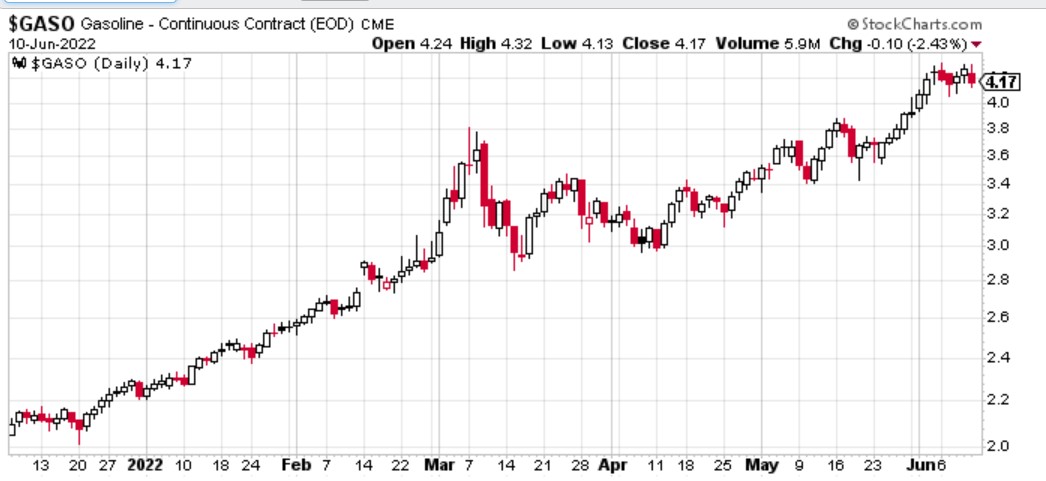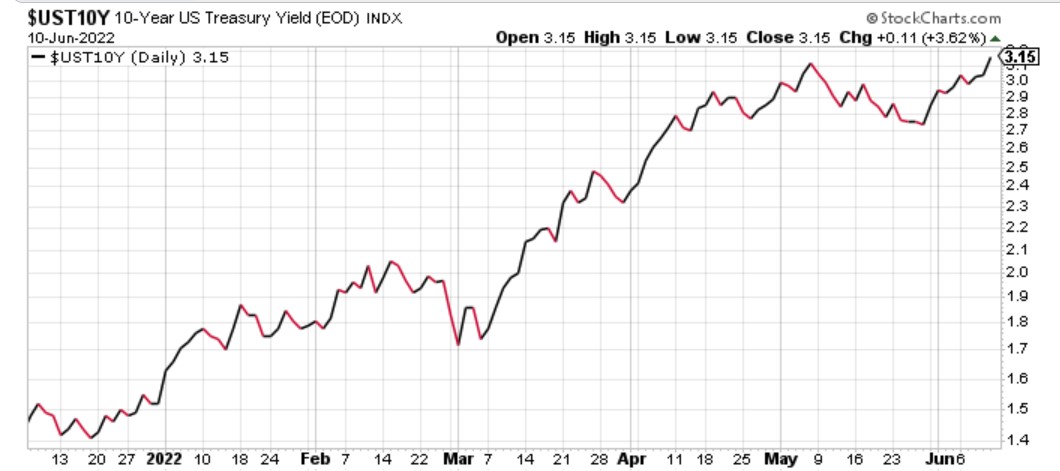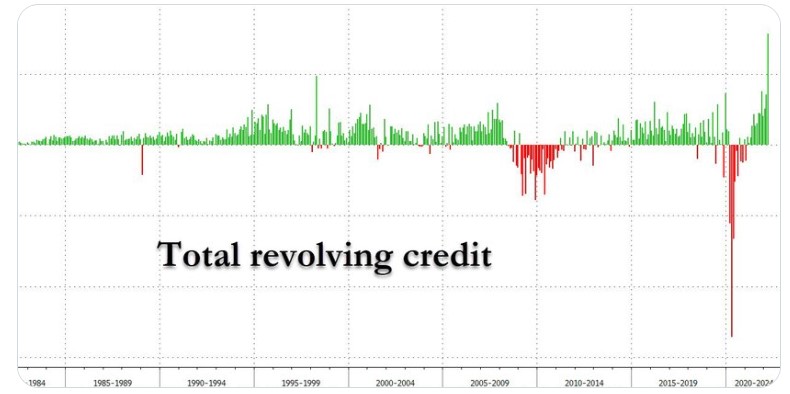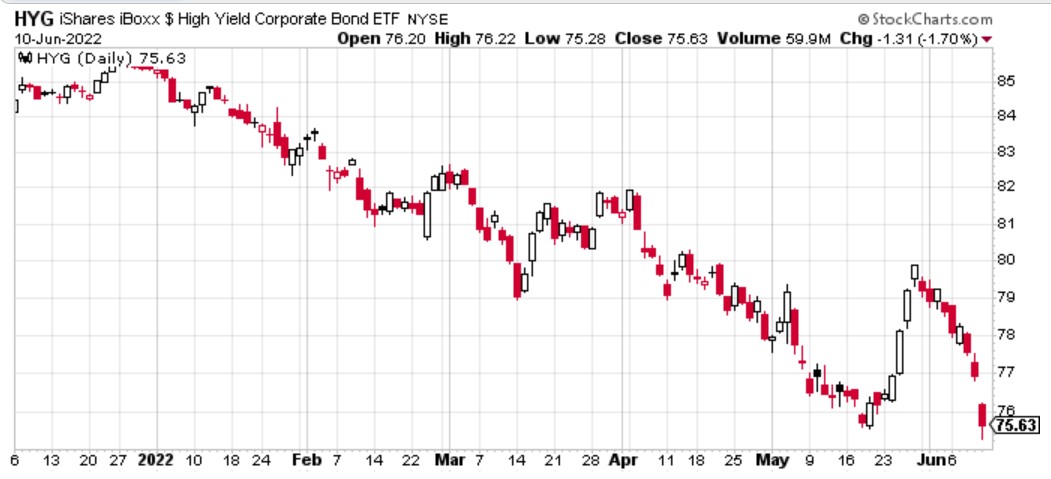Having grown up in the ‘60s and attended college in the late ’70s, I vividly remember my father telling me, “Cost of everything is going through the roof.”
It was an often-used sentence by people living in the ’70s. That was the last time inflation was this out of control.
Take a look at a sampling of extraordinary year-over-year price increases that consumers are now faced with daily:
Groceries +11.9% (Largest since 1979)
Chicken +17.4%
Restaurants +9% (Largest ever)
Fuel oil +107% (Largest ever)
Electricity +12% (Largest ever)
Rent +5.2% (Largest since 2006)
Airfare +37.8% (Largest since 1987)
Important Market Insight From Friday’s Bear Market Trend Continuation Day
As you probably know, in rational times, the biggest stock and bond investors tend to make their investment decisions based on their view of the earnings outlook 6-12 months in the future rather than what’s happening today. On Friday, many of them changed their view of the future.
To that end, for the better part of a year, in this Market Outlook, we’ve been saying that “something is not quite right.” Mish has also been warning of an upcoming period of worrisome stagflation in her regular TV appearances and in her Mish’s Daily commentary.
Stocks hate stagflation.
In last week’s Market Outlook, Economic Storms Ahead?, we highlighted the same feelings of concern about the economy and inflation being expressed by Janet Yellen and two high-profile CEOs. While these were just “statements” to some, they represent what veteran market participants might call “animal spirits.”
As you just read in the inflation statistics above, it’s easy to see now that there’s a problem with inflation. The next likely hot topic will be GDP growth (or lack thereof). We’ll come back to growth later (below) because Friday’s market pounding was related to inflation more than GDP growth.
When the market faces very bad (i.e., record breaking) news as we’ve experienced for months in the inflation data, forward thinkers (big institutions) begin to look for evidence of a turning point.
When it comes to the inflation problem, one turning point in “Wall Street slang” is “peak inflation.” You may have heard the term discussed in the media as it has become a somewhat popular idea.
As of Thursday of last week, there was a substantial segment of the market that believed that, while inflation was very negative for stocks, it had peaked at 8.3% in last month’s report.
On Friday, the government released May’s inflation data (CPI), and it proved that inflation didn’t peak at the 8.3% level.
The “inflation has peaked” believers were expecting a better monthly and year-over-year number. The report, however, was a hotter 8.6% YOY number. Even worse, the monthly number was 1.0% versus the estimated 0.60%.
If you do the math, that is an annualized number of approximately 12%.
Friday’s big move lower in the market reflects an unwinding of the widespread belief that inflation had peaked. Considering the very bearish price action, it may take more than one day for the market to digest the unexpected news.
Mish appeared on TD Ameritrade TV on Friday, and she did an outstanding job of explaining that inflation is well above the 12% rate.
The ex-Food & Energy number moderated to 6% annualized inflation. After the CPI data release, I saw a replay of President Biden at a press conference from LA telling the public that ex-food & energy moderated.
Are they kidding?
Who goes through life without Food & Energy?
As my father used to say, “Gasoline and Food costs are going through the roof.”
Remember from above…
Groceries +11.9% (Largest since 1979)
Fuel oil +107% (Largest ever)
More specifically, see the price of gasoline futures below:

You will notice that the price of gasoline (futures) has gone from $2.20 at the beginning of 2022 to approximately $4.17, almost a 100% increase, and that’s not even a whole year’s change.
Please note that the price of futures is what the core price of gasoline is before it is processed with various leaded components, before distribution costs, before Federal and State taxes are imposed and before dealer profit is priced in. (Gasoline stations).
Given the actual shortage that the US is now experiencing from demand, global supply issues, and the boycotting of Russian oil, the price may continue rising even though the National average is now at $5.00 a gallon or more. I recently paid close to $6 a gallon this week for Premium Unleaded in Ohio.
Of course, rising interest rates along with Friday’s terrible inflation numbers led to a two-day rout in the stock market. It stopped the short-term rally we were experiencing dead in its tracks and contributed to the market closing down for ninth of the past 10 weeks.
Folks, this is what a bear market looks like, and yet it’s not officially be labeled one because the S&P has yet to close down 20%. A close under 3800 would be the official number to declare a “media official” bear market.
But ask any investor who has seen this show before, and they’ll likely agree….we’re there.
For example, in bear markets, it’s typical to see negative 2-3% fast losing days. As we have explained numerous times, you will get fierce and dramatic corrective waves up. We just experienced a 7% corrective wave up, followed by two bear market trend continuation days DOWN.
With rising prices (especially gasoline) and rising interest rates, we are in for an extended period of STAGFLATION.
The Fed is now boxed into a corner, and they need to take swift and perhaps more aggressive (hawkish) action. The interest rate market understands this and rose dramatically in the past few days. See the chart below:

In just 3 months, the 10-year Treasury rate has skyrocketed from 1.8% to 3.15%—a record-breaking rate of change. Unfortunately, we believe they are headed higher.
This is occurring while the Fed has begun to drain its balance sheet of liquidity, something most economists believe should have begun long ago. This is likely to exacerbate the trend of rising interest rates.
We have also discussed in our recent Market Outlook publications that the negative effect of rising costs will eventually have a demand destruction effect on consumer demand.
People are now faced with the hard decisions of where their consumer spending should go. Do they fill up their tank and NOT go out to dinner or buy a new wardrobe? Or, for that matter, should they lower their quality of food purchases at the grocery store. Hard choices. A very real and painful impact of stagflation.
Credit Card Debt May Be An Even Bigger Problem
On Wednesday, the Federal Reserve released its report card on Consumer debt. While it is traditionally viewed as a B-grade economic indicator, the April consumer credit report from the Federal Reserve was another shocker, especially after last month’s shocker report that showed April debt saw the biggest increase in revolving credit on record.
See the credit chart below:

This helped spook the High Yield Debt market via iShares iBoxx $ High Yield Corporate Bond ETF (NYSE:HYG), and after a rally that led equities higher the past two weeks, the prices of junk bonds fell off a cliff.
See below:

Where To Invest Now?
The principal motive during this type of market is to preserve capital so that you make it to the next up market. We have said that on numerous occasions. Even though we have several (more than 5) of our investment strategies up on the year, we offer up these suggestions as some timely advice. Many have been repeated here before:
- Do not let anyone, including your Advisor, talk you into being more invested than your comfort level.
- Cash is king. If you will feel better moving to the sidelines, do so, and don’t let anyone give you a rationale that you HAVE to be invested. Major brokerage firms like to do this. Do not let them.
- Cheap can get cheaper.
- This is a TRADER’S market, not a buy and hold market. Your stocks that are down can get cheaper yet.
- Watch the slope, distances, and levels of the 50-day and 200-day moving averages on each stock or market index you are interested in. Mish gave a free lesson on how to do this at the virtual Money Show last week, which you can see here.
- If you want to be more aggressive, invest in market index INVERSE ETFs. We were up over 5% on one of these just Friday alone that is in our Sector Plus Moderate investment strategy (this model is up over 10% year-to-date).
- Purchase put options on the markets to help offset losses from your other holdings or to participate in the market potentially going further down.
Market Insights From Our Big View Service:
Risk Off
- The response to Friday’s CPI was nasty for every major market index, with 3 of the 4 key indices making breakaway downside gaps on the open Friday and closing near their 2022 weekly closing lows. (-)
- Volume analysis shows an uptick in distribution days over the past 2 weeks, not at all surprising with all of the key indices down at least -4.5% on the week. (-)
- Every sector closed negative on the week, led down by speculative sectors including Semiconductors (SMH) -7.4% and Transportation (IYT) -7.1%, while inflationary plays such as Energy (XLE) only down -0.9% managed to hold on. (-)
- The biggest market hotspots this week were Energy plays USO and UNG as well as Commodities—DBC, GLD, and CORN. (-)
- Market internals retreated from overbought levels, with more room for further downside before reaching oversold levels for both SPY and COMPX. (-)
- The New High/New Low ratio for the NASDAQ continues to languish as the number of new 52-week lows spiked to end the week. (-)
- Despite being nearly full risk-on leading up to Friday, Risk Gauges dropped to zero to end the week in full bear territory. (-)
- Unsurprisingly, sentiment indicators spiked on Friday with Volatility—ProShares VIX Short-Term Futures ETF (NYSE:VIXY)—closing the week in a bullish phase (-)
- The number of stocks above their 10-day and 50-day moving averages continues to decrease, meaning that any kind of bounce in the near term is likely to be limited. (-)
- Interest rates got hit hard with the release of new CPI data and more rate increases are likely still in store which will just add more pressure to equities. (-)
- On this week’s selloff Growth stocks—Vanguard Growth Index Fund ETF Shares (NYSE:VUG)—got hit the hardest, reversing the recent short-term leadership over Value stocks—Vanguard Value Index Fund ETF Shares (NYSE:VTV) (-)
- Every member of Mish’s Modern Family rejected their 50-day moving averages and tumbled to close the week in Bear phases. (-)
- Emerging Markets—iShares MSCI Emerging Markets ETF (NYSE:EEM)—which has large exposure to the far-East and China held up quite a bit better than US Equities, although still closed in a bearish phase. (-)
- Copper—Global X Copper Miners ETF (NYSE:COPX)—failed its bull phase this week and actually closed below its 200-day moving average, while Soft Commodities—Invesco DB Agriculture Fund (NYSE:DBA)—actually held up on a relative basis once again resuming leadership over the S&P. (-)
- Gold (GLD) finally ran true to expectations with its big move on Friday +1.3% and closing above its 200-day moving average, poised to improve to a bull phase at this rate. (-)
Neutral
- China—iShares China Large-Cap ETF (NYSE:FXI)—+2.73% on the week was the only positive performing country ETF, a significant holding in Mish’s portfolio. (=)
